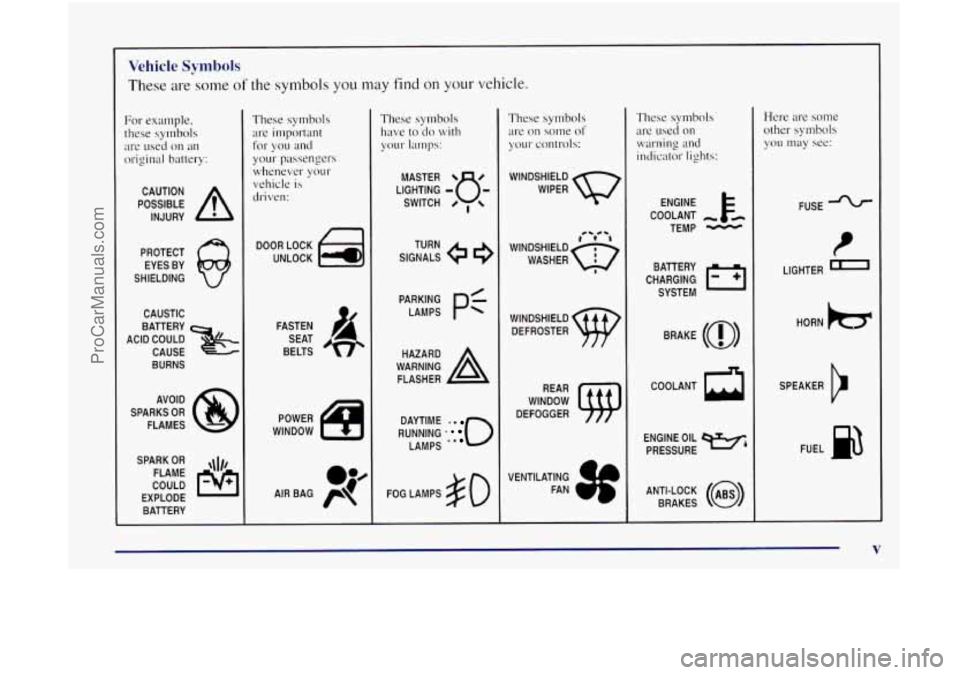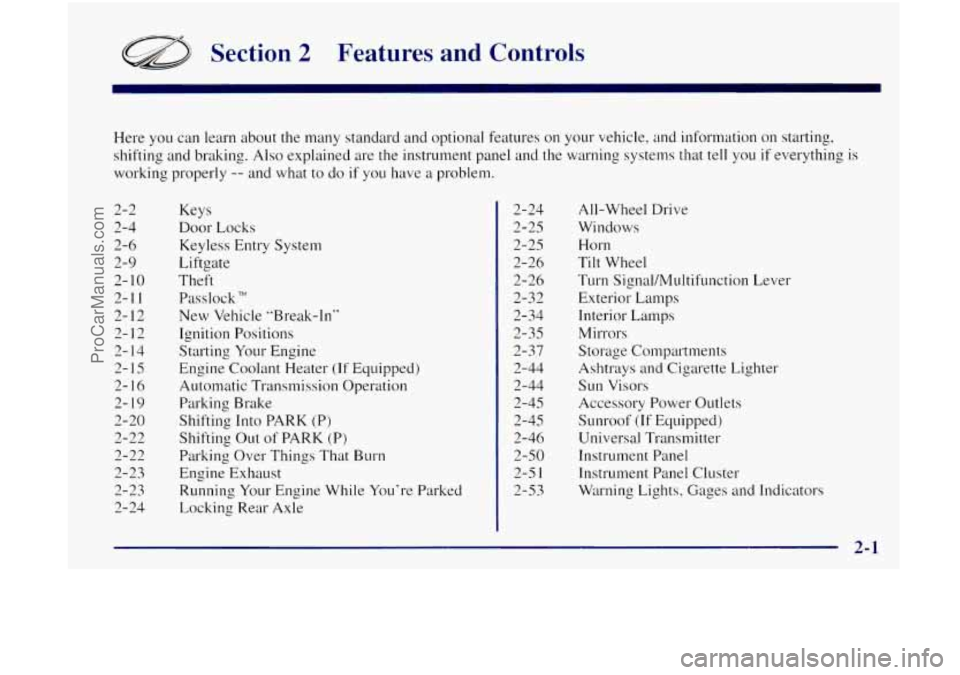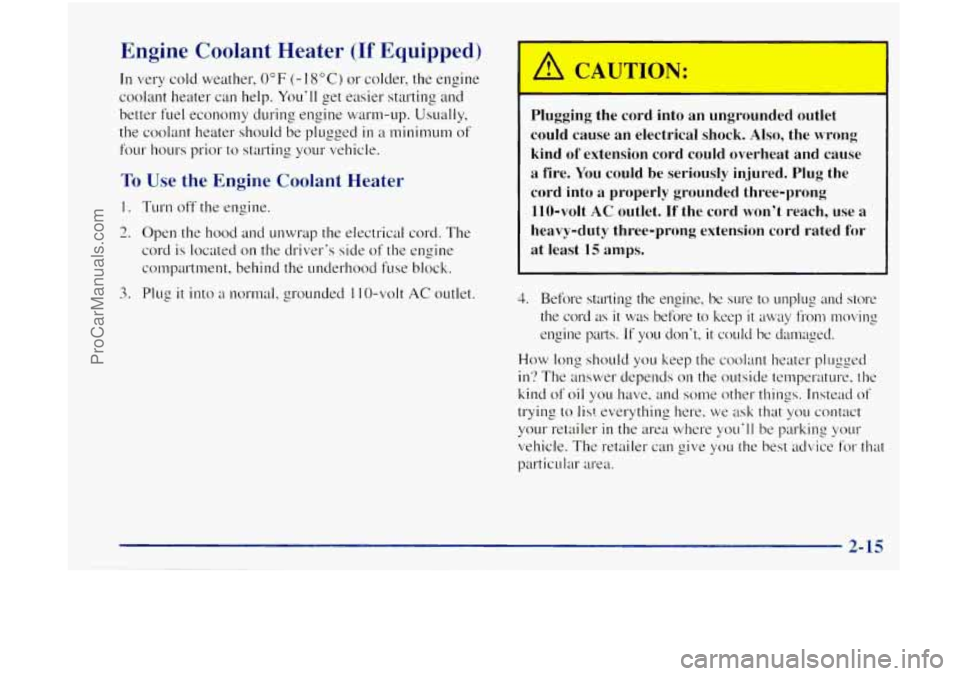engine coolant OLDSMOBILE BRAVADA 1998 Owners Manual
[x] Cancel search | Manufacturer: OLDSMOBILE, Model Year: 1998, Model line: BRAVADA, Model: OLDSMOBILE BRAVADA 1998Pages: 380, PDF Size: 19.2 MB
Page 11 of 380

Vehicle Symbols
These are some of the symbols you may find on your vehicle.
For example,
these symbols
are used on
an
original battery:
POSSIBLE A
CAUTION
INJURY
PROTECT EYES BY
SHIELDING
CAUSTIC
ACID COULD
x
BATTERY
CAUSE
BURNS
AVOID
SPARKS
OR
FLAMES
SPARK
OR ,\I/,
COULD
FLAME
EXPLODE BATTERY
These symbols
are important
your passengers
whenever your
vehicle
is
driven:
for
you and
FASTEN
SEAT
BELTS
These symbols
have
to do with
your lamps:
SIGNALS 9
TURN
RUNNING
' 0
DAYTIME .
LAMPS **
FOG LAMPS $0
These symbols
are on some
of
your controls:
WINDSHIELD
WIPER
CS 0b
WINDSHIELD DEFROSTER
WINDOW
DEFOGGER
VEN TlLATlNG
FAN
These symbols are
used on
warning and
indicator lights:
COOLANT -
TEMP -
CHARGING BAllERY
SYSTEM
BRAKE
(0)
COOLANT a
ENGINE OIL w,
PRESSURE
Here are some
other symbols
you may see:
FUSE
LIGHTER
n
HORN )tr
SPEAKER
b
FUEL p3
ANTI-LOCK (@)
BRAKES
V
ProCarManuals.com
Page 65 of 380

a Section 2 Features and Controls
Here you can learn about the many standard and optional features on your vehicle, and information on starting,
shifting and braking. Also explained are
the instrument panel and the warning systems that tell you if everything is
working properly
-- and what to do if you have a problem.
2-2
2-4
2-6
2-9
2-
10
2-1 1
2- 12 2- 12
2- 14
2- 15
2-16
2- 19
2-20
2-22
2-22
2-23
2-23
2- 24 Keys
Door Locks
Keyless Entry System
Liftgate
Theft Passlock
TM
New Vehicle “Break-In”
Ignition Positions
Starting Your Engine
Engine Coolant Heater
(If Equipped)
Automatic Transmission Operation
Parking Brake
Shifting Into PARK
(P)
Shifting Out of PARK (P)
Parking Over Things That Burn
Engine Exhaust
Running Your Engine While You’re Parked
Locking Rear Axle 2-24
2-25
2-25
2-26
2-26
2-32 2-34
2-35
2-37 2-44
2-44
2-45
2-45 2-46
2-50
2-5
1
2-53 All-Wheel Drive
Windows Horn
Tilt Wheel
Turn Signal/Multifunction Lever
Exterior Lamps
Interior Lamps
Mirrors
Storage Compartments Ashtrays and Cigarette Lighter
Sun Visors
Accessory Power Outlets
Sunroof (If Equipped)
Universal Transmitter Instrument Panel
Instrument Panel Cluster
Warning Lights, Gages and Indicators
ProCarManuals.com
Page 79 of 380

Engine Coolant Heater (If Equipped)
In very cold weather, 0°F (-18°C) or colder, the engine
coolant heater can help.
You’ll get easier starting and
better fuel economy during engine warm-up. Usually,
the coolant heater should be plugged
in a minimum of
four hours prior to starting your vehicle.
To Use the Engine Coolant Heater
1. Turn off the engine.
2. Open the hood and unwrap the electrical cord. The
cord is located
on the driver’s side of the engine
compartment, behind the underhood fuse block.
3. Plug it into a normal, grounded 1 10-volt AC outlet.
Plugging the cord into an ungrounded outlet
could cause an electrical shock.
Also, the wrong
kind
of extension cord could overheat and cause
a fire. You could be seriously injured. Plug the
cord into
a properly grounded three-prong
110-volt
AC outlet. If the cord won’t reach, use a
heavy-duty three-prong extension cord rated
for
at least 15 amps.
4. Before starting the engine, be sure to unplug and store
the cord as it was before to keep it away from moving
engine parts.
If you don’t, it could be damaged.
How
long should you keep the coolant heater plugged
in?
The answer depends on the outside temperature, the
kind
of oil you have, and some other things. Instead of
trying to list everything here. we ask that you contact
your retailer
in the area where you’ll be parking your
vehicle. The retailer can give
yo11 the best advice for that
particular area.
ProCarManuals.com
Page 121 of 380

Anti-Lock Brake System Warning Light
~ With the anti-lock brake
system, this light will
come on when you start
your e.ngine and may stay
on
for several seconds.
That’s normal.
If the light stays on, or comes on when you’re driving,
your vehicle needs service.
If the regular brake system
warning light
isn’t on, you still have brakes, but you
don’t have anti-lock brakes.
If the regular brake system
warning light
is also on, you don’t have anti-lock brakes
and there’s
a problem with your regular brakes. See
“Brake System Warning Light“ earlier
in this section.
The anti-lock brake system warning light should come
on briefly when you
turn the ignition key to RUN. If the
light doesn’t come on
then, have it fixed so it will be
ready to warn you
if there is a problem.
Engine Coolant Temperature Gage
This gage shows the
engine coolant temperature.
If the gage pointer moves
into the red area. your
engine is too hot!
It means that your engine coolant has overheated. If you
have been operating your vehicle under normal driving
conditions, you should pull
off the road. stop your
vehicle and
turn off the engine as soon as possible.
In “Problems on the Road,“ this manuill shows you what
to do. See “Engine Overheating”
in the Index.
2-57
ProCarManuals.com
Page 126 of 380

Check Gages Light
CHECK
GAGES
The CHECK GAGES light
will come on briefly when
you are starting the engine.
Gate Ajar
GATE
AJAR
This light will come on
briefly when you are
starting your engine.
If the light comes on and stays on while YOLI are driving, If it stays on, you’re liftgate is ajar. Try closing the
check your coolant temperature and engine
oil pressure liftgate again. Never drive with the liftgate even
gages
to see if they are in the warning zones.
partially open.
2-62
ProCarManuals.com
Page 131 of 380

~ . le Knob - Automatic
Operation
I he right knob on the control panel allows you to
choose the direction of air delivery. When the system is
set
for automatic operation, sensors will control the air
delivery mode. Air will come primarily from the floor
or
instrument panel outlets, with some air directed to the
windshield to prevent fogging.
When the system is
in AUTO mode, the air conditioning
light will turn on, and
the recirculation and outside air
lights
turn off. With the system in full auto control
(both the fan and mode knobs
in AUTO), YOLI still
have the ability to override any function. However?
continually overriding the outside air or the A/C
compressor will
limit the ability of the system to cool
the vehicle quickly.
If you push a button for a function which is not
available, the light next to that button
will flash three
times to alert you that it's
not available.
To find your comfort zone, start with the
74°F (23°C)
setting and allow about 20 minutes for the system to
adjust the temperature
if necessary.
With the automatic setting, the air conditioning
compressor automatically cycles when needed to cool
the air.
In cold weather, when the system senses the need
for heat, the airflow will be directed out the floor outlets.
As the
interior temperature approaches a desired
setting,
the blower speed will decrease. To maintain
interior comfort, the airflow will adjust between the
instrument panel air outlets and
floor outlets. On bright
sunny days in cool weather, the airflow may come out
of
the air conditioning and floor outlets (bi-level mode) to
maintain comfort and prevent stuffiness.
To avoid blowing cold air
in cold weather, the system
will delay turning on the fan until warm air is available.
The length of delay depends on the outside air
temperature, engine coolant temperature or the time
since the engine was last started.
As the coolant
warms
up, the blower fan speed will gradually increase
and air will flow from the heater outlets, with some
airflow to the windshield to prevent fogging under most
normal conditions.
If your vehicle is sitting out on a warm day and you
have the filn set on AUTO, the air
will first flow out of
the floor air outlets for
a few seconds. That is normal.
This is to expel hot air from the air outlets.
As the air is
cooled, the airflow
will move through the air
conditioning outlets.
Be careful
not to put anything over the solar sensor
located around the center of the instrument panel.
This sensor is used by the automatic system
to
regulate temperature.
3-3
ProCarManuals.com
Page 133 of 380

Remember that in order for the automatic system
to perform
well, it needs A/C to provide
cooling performance.
Air Conditioning
On hot days, open the windows long enough to let hot
inside air escape. This reduces the time
it takes for your
vehicle to cool down. Then keep your windows closed
for the air conditioner to work its best.
For quick cool-down on very hot days, use
MAX A/C
with the temperature knob turned to the left. This setting
should be used to keep odors and/or dust from entering
the vehicle. For normal cooling on hot days, use A/C
with the temperature knob turned to the left.
On cool but sunny days, use BI-LEVEL A/C to deliver
warm air to the floor and cooler air to the instrument
panel outlets.
When the air conditioner is on, you may sometimes notice
slight changes
in your vehicle‘s engine speed and power.
This
is normal because the system is designed to cycle the
compressor on and off to keep the desired temperature.
Heating
The heater works best if you keep your windows closed
while using
it. On cold days, use HEATER with the
temperature knob turned
to the right. BLEND is useful
in cool weather when you have fog or ice on the
windshield or side windows.
If you use the optional engine coolant heater before
starting your engine, your heating system will produce
warmer air faster to heat the passenger compartment in
cold weather. See “Engine Coolant Heater”
in the Index.
Ventilation System
For mild outside temperatures when little heating or
cooling
is needed, use VENT to direct outside air
through your vehicle. Airflow is through the instrument
panel outlets.
Your vehicle’s ventilation system supplies outside air to
the inside of your vehicle when
it is moving. When the
vehicle is
not moving, you can get outside air to flow
through by selecting any mode and any fan speed.
3-5
ProCarManuals.com
Page 219 of 380

Engine Overheating
You will find a coolant temperature gage on your
vehicle's instrument panel. See "Gages" in the Index.
1 [f Steam Is Coming From Your Engine
Steam from an overheated engine can burn you
badly, even if you just open the hood. Stay away
from the engine if you see or hear steam coming
from it. Just turn it off and get everyone away
from the vehicle until it
cools down. Wait until
there is no sign
of steam or coolant before you
open the hood.
If you keep driving when your engine is
overheated, the liquids in it can catch fire.
You or
others could be badly burned. Stop your engine if
it overheats, and get out of the vehicle until the
engine is
cool.
I NOTICE: I
If your engine catches fire because you keep
driving with no coolant, your vehicle can be
badly damaged. The costly repairs would not be
covered
by your warranty.
5-13
ProCarManuals.com
Page 221 of 380

When you decide it's safe to lift the hood, here's what
you'll see: If the coolant inside the coolant recovery tank is boiling,
don't do anything else until
it cools down.
A. Coolant Recovery Tank
B. Radiator Pressure Cap
C. Engine Fan
The coolant level should be at least up to the ADD mark.
If it isn't, you may have a leak in the radiator hoses,
heater hoses, radiator, water pump or somewhere else
in
the cooling system.
5-15
ProCarManuals.com
Page 222 of 380

U
Heater and radiator hoses, and other engine
parts, can be very hot. Don’t touch them.
If you
do, you can be burned.
Don’t run the engine if there is a leak.
If you run
the engine, it could lose all coolant. That could
cause an engine fire, and you could be burned.
Get any leak fixed before you drive the vehicle.
1 NOTICE:
Engine damage from running your engine
without coolant isn’t covered by your warranty.
If there seems to be no leak, start the engine again. See if
the engine cooling fan speed increases when idle speed is
doubled by pushing the accelerator pedal down. If it
doesn’t. your vehicle needs service. Turn off the engine.
How to Add Coolant to the Coolant
Recovery Tank
If you haven’t found a problem yet, but the coolant level
isn’t at the
ADD mark. add a 50/50 mixture of clecrn
\,L*crtet- (preferably distilled) and DEX-COOL@ engine
coolant
at the coolant recovery tank. (See “Engine
Coolant”
in the Index for more information.)
I A CAUTION:
Adding only plain water to your cooling system
can be dangerous. Plain water, or some other
liquid like alcohol, can boil before the proper
coolant mixture will. Your vehicle’s coolant
warning system
is set for the proper coolant
mixture. With plain water or the wrong mixture,
your engine could get
too hot but you wouldn’t
get the overheat warning. Your engine could
catch fire and you or others could be burned.
Use
a 50/50 mixture of clean water and
DEX-COOL@ coolant.
I
5-16
ProCarManuals.com